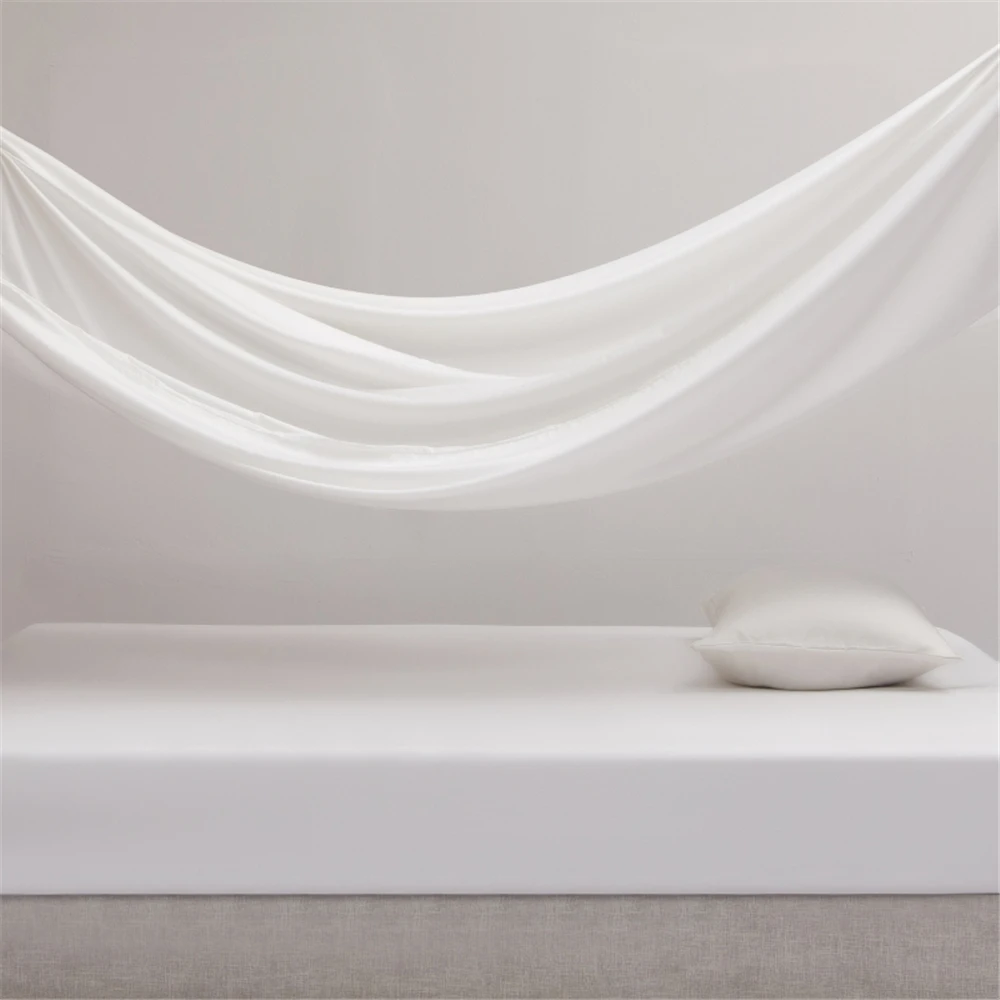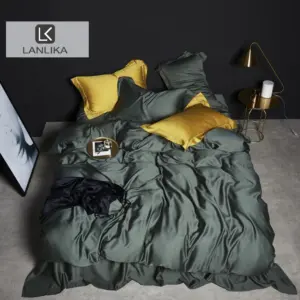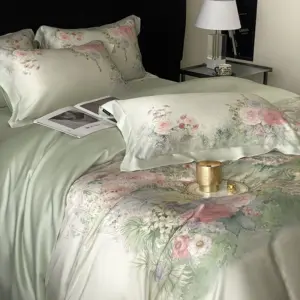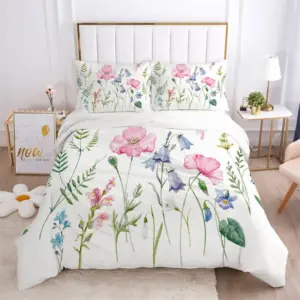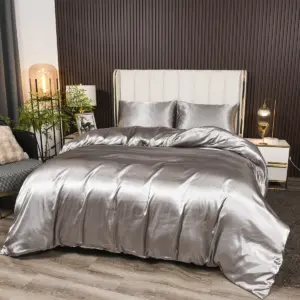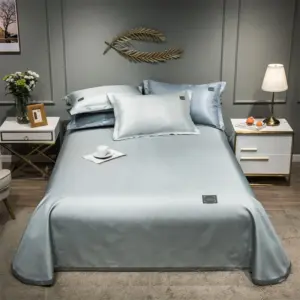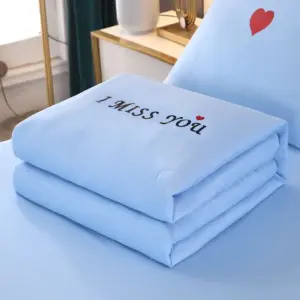Introduction to Luxury Silk Bedding: Understanding the Investment
Investing in full silk bedding transforms your sleeping experience into something truly extraordinary. When we talk about “full silk bedding,” we’re referring to a complete set that includes silk sheets, pillowcases, duvet covers, and often silk-filled duvets or comforters. Unlike conventional bedding materials, silk offers unique properties that justify its premium status in the world of luxury sleep.
Silk stands apart from standard cotton bedding through its exceptional smoothness, natural temperature regulation, and gentle interaction with skin and hair. These distinctive qualities make silk bedding not just a purchase but a meaningful investment in your sleep quality and overall wellbeing.
As you explore options for silk bedding, you’ll need to understand several key factors that determine quality and suitability for your needs:
- Momme weight (silk’s density measurement)
- Silk type and grade (with 6A Mulberry silk being the gold standard)
- Weave patterns and construction details
- Certifications that ensure authenticity and safety
- Care requirements that preserve your investment
While quality silk bedding represents a higher initial investment than conventional alternatives, its exceptional durability and benefits make it cost-effective over time when properly maintained.
This guide aims to equip you with the knowledge needed to make an informed decision when investing in full silk bedding that meets your specific needs and preferences.
Why Premium Silk Bedding Transforms Your Sleep Experience
Natural Temperature Regulation
One of the most remarkable features of high-quality silk bedding basics is their ability to regulate temperature. Silk naturally wicks away moisture while maintaining ideal warmth, keeping you comfortably cool in summer and pleasantly warm in winter. This thermoregulation happens because silk fibers contain amino acids that respond to your body’s temperature and humidity levels—something synthetic materials simply cannot replicate.
Hypoallergenic Protection
For allergy sufferers, silk offers significant relief. The tight weave and natural protein structure of silk resist dust mites, mold, and common allergens. Additionally, genuine silk contains natural proteins that are antimicrobial, creating a cleaner sleep environment compared to conventional bedding materials.
Skin Benefits
The smooth surface of silk minimizes friction against your skin, preventing sleep creases and reducing irritation. The natural proteins in silk also help maintain your skin’s moisture balance, unlike cotton which can absorb moisture from your skin. Many dermatologists recommend luxury silk bedding for those with sensitive skin or concerns about facial wrinkles.
Hair Protection
The same friction-reducing properties that benefit your skin also work wonders for your hair. Silk’s smooth surface prevents the tangling, breakage, and frizz that rougher fabrics can cause. Hair glides across silk pillowcases rather than catching and pulling, helping maintain styles longer and reducing morning bedhead.
Exceptional Durability
When properly cared for, premium silk bedding often outlasts other luxury fabrics. The natural strength of silk fibers creates a durable material that resists wear while maintaining its signature softness and sheen through many years of use.
Incomparable Comfort
Perhaps most immediately noticeable is silk’s extraordinary sensory experience. The lightweight feel combined with natural sheen and exceptional smoothness creates a luxurious sleep environment unlike any other material. Many users describe the sensation of sleeping on silk as “floating” rather than simply lying in bed.
Understanding these benefits helps explain why silk bedsheets are worth the investment for those seeking the ultimate sleep experience. With this foundation in place, let’s examine the specific quality indicators you should consider when selecting silk bedding.
Momme Weight: The Critical Density Measurement for Silk Quality
Momme weight (pronounced “moe-mee”) serves as the essential measurement of silk density and quality. Similar to thread count in cotton, momme weight indicates how many grams of silk are in a piece of fabric measuring 100 yards by 45 inches. This critical measurement directly impacts the durability, drape, and overall feel of your silk bedding.
For bedding applications, the ideal momme weight typically falls between 19 and 25 momme. This range offers the optimal balance between luxurious softness and long-term durability. Here’s how different momme weights compare:
| Momme Range | Characteristics | Best For |
|---|---|---|
| 16-18 mm | Lighter, more translucent, moderately durable | Budget options, summer use, liner fabrics |
| 19-22 mm | Balanced weight, good opacity, excellent durability | Year-round bedding, pillowcases, sheets |
| 23-30 mm | Heavier, very opaque, maximum durability | Premium bedding, duvet covers, long-term investment |
When examining silk bedding, higher momme doesn’t always mean better quality for every application. While a higher momme indicates more silk content and typically greater durability, it also creates a slightly heavier fabric that may not have the ethereal lightness some prefer. The momme weight matters significantly when selecting the right balance for your preferences.
To identify potential false advertising, hold silk fabric up to light—lower momme weights will be more translucent. Genuine 19+ momme silk will have a substantial feel while maintaining elegant drape. Many reputable sellers provide detailed information about momme weight in silk bedding, reflecting confidence in their product quality.
Remember that momme weight should be considered alongside other quality factors like silk type and grade, which we’ll explore next.
Understanding Silk Types: Why 100% Mulberry Silk Reigns Supreme
When exploring silk bedding options, you’ll quickly discover that not all silk is created equal. 100% Mulberry silk stands as the gold standard for luxury bedding, offering superior qualities that other varieties simply cannot match.
Mulberry silk comes from silkworms (Bombyx mori) that feed exclusively on mulberry leaves under controlled conditions. This specialized diet and careful cultivation produce exceptionally long, uniform silk fibers with remarkable consistency in texture and color. The result is a supremely soft, lustrous fabric with unparalleled smoothness.
In contrast, other silk varieties offer different characteristics:
Tussah silk (sometimes called “wild silk”) comes from silkworms that feed on oak and juniper leaves in uncontrolled environments. This produces shorter, coarser fibers with an uneven texture and natural tan color that cannot be bleached fully white. While Tussah has its place in some textiles, it lacks the refined smoothness needed for premium bedding.
Habotai silk, though still made from mulberry silkworms, undergoes less meticulous processing, resulting in a thinner, less durable fabric. While less expensive, Habotai lacks the substantial feel and longevity of proper Mulberry silk bedding.
It’s important to note that when product labels simply say “silk” without specifying “100% Mulberry,” this often indicates either a blend or an inferior silk variety. Similarly, Charmeuse refers to a specific weaving method rather than a type of silk—this distinction matters because even lower-quality silk can be woven in a Charmeuse pattern.
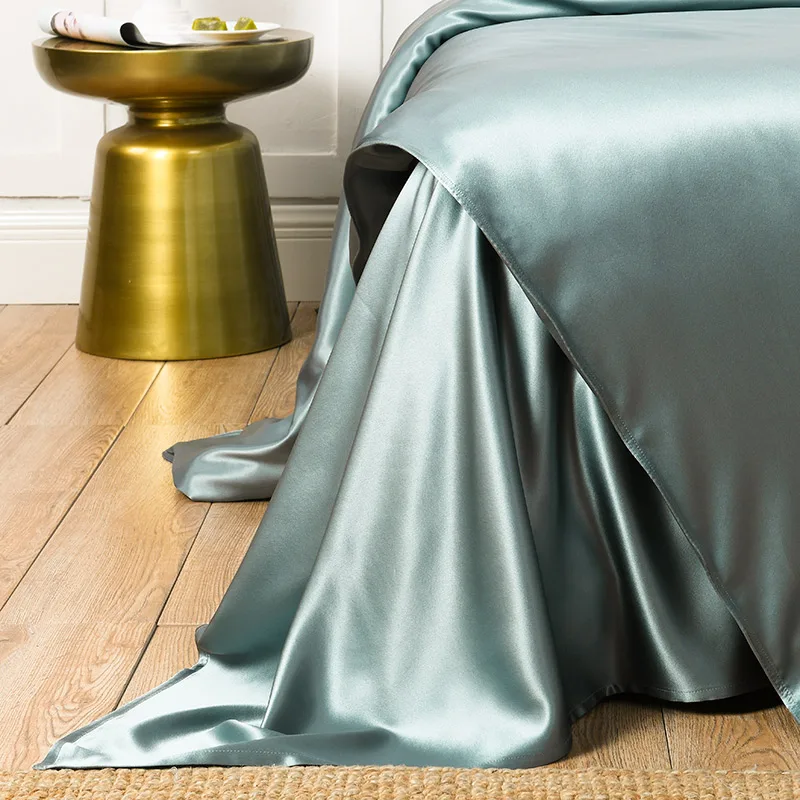
For truly luxurious bedding, choosing mulberry silk sheets ensures you receive the optimal combination of softness, durability, and natural sheen that makes mulberry silk bedding sets so desirable.
Silk Grade Decoded: The Importance of 6A Classification
Within the world of Mulberry silk exists a hierarchical grading system that further differentiates quality levels. This system ranges from grade A to C, with A being the highest quality classification. Within grade A, there are six sub-grades (1A through 6A), with 6A representing the absolute pinnacle of silk quality.
What makes 6A grade special:
* Exceptionally long and uniform fibers
* Maximum consistency in thickness and texture
* Superior tensile strength
* Enhanced natural luster
* Finest level of weaving precision
* Optimal color absorption during dyeing
The difference between grades becomes apparent in the fabric’s performance and appearance. Lower-grade silk may have slight irregularities in texture, less pronounced sheen, and reduced durability over time. In contrast, 6A grade silk provides consistently smooth texture, vibrant and even color saturation, and maximum resilience through years of use.
When verifying claims about 6A grade silk, look for sellers who provide transparent information about their sourcing and quality control processes. Reputable brands like Sanctuary Soft subject their silk to rigorous testing for strength, color consistency, and tactile quality before assigning the premium 6A classification.
Warning signs that may indicate falsely claimed grades include unusually low pricing for claimed 6A silk, reluctance to provide detailed specifications, or lack of proper certification. Genuine 6A grade silk represents a higher investment but delivers noticeably superior silk quality that becomes increasingly apparent over years of use.
Combining top-grade silk with appropriate momme weight creates the foundation for exceptional mulberry silk sheets that transform ordinary sleep into extraordinary luxury.
Weave Patterns: Selecting the Ideal Silk Construction
The weave pattern used in silk bedding significantly impacts both its appearance and performance. Understanding these patterns helps you select bedding with the perfect combination of aesthetic appeal and functional benefits for your needs.
Charmeuse weave stands as the most popular choice for luxury silk bedding, characterized by:
* A distinctly smooth, glossy face side with flowing drape
* A more matte, textured reverse side
* Excellent balance between breathability and insulation
* The characteristic “slip” that protects hair and skin
* Enhanced luster that showcases silk’s natural sheen
This asymmetrical weave creates bedding with two different textures—many users prefer the smooth side against skin while appreciating the more matte side for visual contrast when the bedding is folded back.
Alternative weaves include:
Habotai (plain weave): This simpler, balanced weave creates a lighter-weight fabric that’s less expensive but also less durable than Charmeuse. The resulting fabric lacks the distinctive drape and luster of Charmeuse silk.
Silk twill: Recognizable by its diagonal rib pattern, twill weaves create extremely durable silk with a more subtle sheen. While very strong, twill lacks the luxurious slip and ultra-smooth surface that makes Charmeuse ideal for direct skin contact.
For bedding applications, Charmeuse typically provides the optimal silk bedding texture by balancing durability with sensory benefits. The weave’s structure enhances silk’s natural properties while creating a substantial fabric that drapes beautifully across your bed.
When selecting your preferred weave, consider how it interacts with the momme weight—higher momme Charmeuse creates exceptionally luxurious bedding with maximum durability, while lighter weights offer more ethereal drape with slightly less longevity.
Critical Quality Indicators: Certifications and Construction Details
Beyond the fundamental specifications of momme weight, silk type, and grade, several additional quality indicators help distinguish truly premium silk bedding from inferior alternatives.
Meaningful Certifications
OEKO-TEX Standard 100 certification provides assurance that silk bedding has been tested and verified to be free from harmful substances. This independent certification confirms the absence of toxic chemicals, ensuring the bedding is safe for direct skin contact.
Other valuable certifications may include those verifying ethical production practices, sustainable sourcing, or specialized testing for durability standards. Reputable manufacturers willingly share their certification details as evidence of their commitment to quality.
Dyeing Process Quality
Premium silk bedding uses non-toxic, azo-free dyes that preserve silk’s natural properties while providing rich, consistent color. Quality dyeing processes ensure colorfastness without compromising the silk’s natural feel or introducing harmful substances. The best dyes maintain color integrity through multiple washing cycles without fading or bleeding.
Construction Excellence
Several construction details separate exceptional silk bedding from average options:
- French seams (where edges are folded twice and enclosed) rather than overlocked edges that may unravel
- Reinforcement at stress points like corners and envelope closures
- Perfectly even stitching with appropriate thread count
- High-quality closures—smooth-operating zippers with protective flaps, securely attached buttons, or generous envelope flaps that fully contain pillows
These construction elements significantly impact both the immediate appearance and long-term durability of your silk bedding. Understanding what’s included in silk bedding sets helps you evaluate these details effectively when making your selection.
Selecting Individual Silk Bedding Components
Creating your ideal silk sleep sanctuary involves selecting each component with attention to its specific requirements and features. Each bedding element has distinct considerations that affect both comfort and functionality.
Silk Sheets
When selecting silk sheets, consider:
* Fitted sheet pocket depth should match your mattress height precisely—too shallow and it won’t stay in place, too deep and it may wrinkle
* Elastic quality in fitted sheets significantly impacts how well they stay positioned
* Flat sheets should offer generous dimensions for proper tucking and drape
* 19-22 momme represents the sweet spot for sheets, balancing softness with durability
Silk Pillowcases
Key pillowcase considerations include:
* Closure type—envelope closures prevent slippage but zipper closures provide a more secure fit
* Size compatibility with your specific pillows (standard, queen, king, or body pillows)
* For beauty benefits, 22-25 momme offers optimal smoothness and durability
* Double-sided Charmeuse construction maximizes skin and hair benefits
Silk Duvet Covers
For duvet covers, prioritize:
* Internal ties or corner holders that secure the insert and prevent bunching
* Closure systems that remain secure yet allow easy access for insert changes
* Matching the dimensions precisely to your duvet insert
* Slightly higher momme weight (22-25) for enhanced durability
Silk-Filled Comforters/Duvets
If selecting a silk-filled duvet:
* Box construction creates pockets that hold fill in place for even distribution
* Fill weight variations accommodate different seasons (lighter for summer, heavier for winter)
* Cover material should complement the silk fill with similar quality standards
* Long-staple silk fill provides superior insulation and moisture management
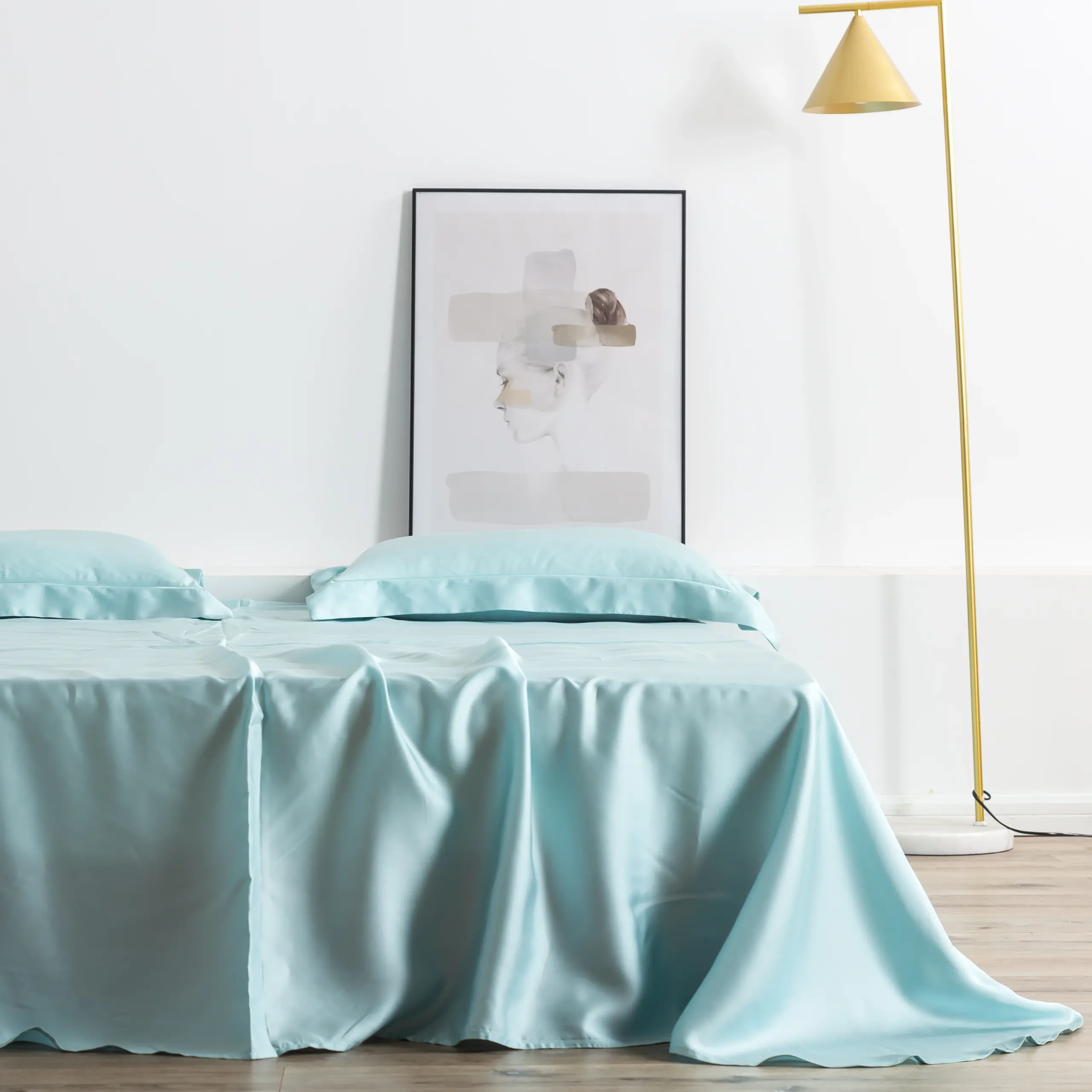
100% Silk Sheets, Green Silk Sheets, King Size Silk Bedding Set, Mulberry Silk Bedding Sets, Queen Size Silk Bedding Set
Price range: $1,246.21 through $1,615.22 Select options This product has multiple variants. The options may be chosen on the product pageEucalyptus Silk Bedding Sets, Eucalyptus Silk Sheets
Price range: $360.24 through $393.60 Select options This product has multiple variants. The options may be chosen on the product pageFull Silk Bedding Set, King Size Silk Bedding Set
Price range: $120.99 through $190.49 Select options This product has multiple variants. The options may be chosen on the product pageGrey Silk Sheets, Silk Sheet and Pillowcase Set
Price range: $88.20 through $146.64 Select options This product has multiple variants. The options may be chosen on the product page- Price range: $267.82 through $306.55 Select options This product has multiple variants. The options may be chosen on the product page
Bamboo Silk Sheets, Cooling Silk Sheets
Price range: $130.76 through $177.80 Select options This product has multiple variants. The options may be chosen on the product page
Selecting each component with careful attention to these details ensures your complete silk sheet and pillowcase set functions optimally while delivering the full spectrum of benefits that make silk bedding exceptional.
Silk Bedding Care Essentials: Preserving Your Investment
Proper care significantly extends the life of your silk bedding, ensuring your investment continues to provide luxury and comfort for years to come. Following specific maintenance protocols preserves silk’s natural properties while preventing common forms of damage.
Washing Protocols
For optimal results when cleaning silk bedding:
* Hand washing offers the gentlest treatment, using lukewarm water (never hot)
* If machine washing, use a mesh laundry bag and select the delicate cycle
* Use only pH-neutral, silk-specific detergents without enzymes or brighteners
* Wash silk items separately from other fabrics to prevent friction damage
* Rinse thoroughly to remove all soap residue
* Wash approximately every 7-14 days, or more frequently during warm weather
Drying Methods
Proper drying techniques prevent damage:
* Air drying is always preferable—lay flat on a clean white towel away from direct heat sources
* If using a dryer, select air-only or lowest heat setting for minimal time
* Never expose silk to direct sunlight when drying, as UV rays damage the fibers
* Expect 2-4 hours for complete air drying, depending on environmental conditions
Storage Practices
Between uses, proper storage extends silk’s lifespan:
* Store in breathable cotton bags rather than plastic, which can trap moisture
* Maintain moderate humidity in storage areas (30-50% humidity is ideal)
* Add cedar blocks rather than mothballs to prevent pest damage
* Fold with minimal creasing rather than hanging for long periods
Common mistakes to avoid include using bleach, wringing or twisting wet silk, and ironing at high temperatures. With proper care, premium silk bedding maintains its exceptional qualities through hundreds of uses.
These care considerations form an important part of your ultimate guide to buying luxury silk bedding, ensuring you protect your investment properly.
Understanding the Price-Quality Relationship in Silk Bedding
When evaluating silk bedding options, understanding the factors that legitimately influence pricing helps you identify genuine value versus marketing hype.
Several characteristics justifiably affect price:
* Higher momme weight requires more raw silk material
* 6A grade silk demands more rigorous selection and quality control
* Certified products undergo additional testing and verification
* Superior construction techniques require skilled craftsmanship
* Larger sizes naturally require more material
* Specialty features like reinforced corners or custom closures add value
To identify fair value versus overpricing, consider the price relative to these quality indicators. Genuine premium silk bedding represents a higher initial investment but offers significant value through:
* Extended useful life compared to conventional bedding
* Reduced replacement frequency due to superior durability
* Enhanced sleep quality that may reduce other health-related expenses
* Skin and hair benefits that might reduce need for specialized treatments
A helpful approach is calculating the “cost per use” by dividing the purchase price by the expected number of nights you’ll use the bedding over its lifetime. This often reveals that quality silk bedding, while initially more expensive, offers competitive or superior long-term value compared to frequently replaced lower-quality options.
It’s important to note that beyond a certain quality threshold, higher prices may reflect brand positioning rather than proportionally better quality. The silk bedding investment delivers its best value when you select items that match your specific needs without paying for unnecessary features.
Red Flags: How to Avoid Counterfeit and Low-Quality Silk
The growing popularity of silk bedding has unfortunately led to an increase in misleading products that fall short of genuine quality standards. Knowing how to identify these inferior options saves you from disappointing purchases.
Misleading Terminology
Watch for these potentially deceptive terms:
* “Silk blend” typically means minimal silk content mixed with synthetic fibers
* “Satin” describes a weave pattern, not a material—most satin is polyester, not silk
* “Silky” or “silk-like” almost always indicates synthetic alternatives
* “Artificial silk” refers to rayon or similar manufactured materials with no actual silk content
Missing Specifications
Quality silk products provide specific details about:
* Precise momme weight (not vague terms like “heavyweight”)
* Exact silk type (specifically “100% Mulberry silk”)
* Silk grade classification
* Weave construction method
Products lacking these specifications often have something to hide about their quality or composition.
Price Indicators
While quality silk represents an investment, prices that seem too good to be true usually are. Genuine 6A grade Mulberry silk at 19+ momme has minimum production costs that make extremely low pricing impossible without compromising quality.
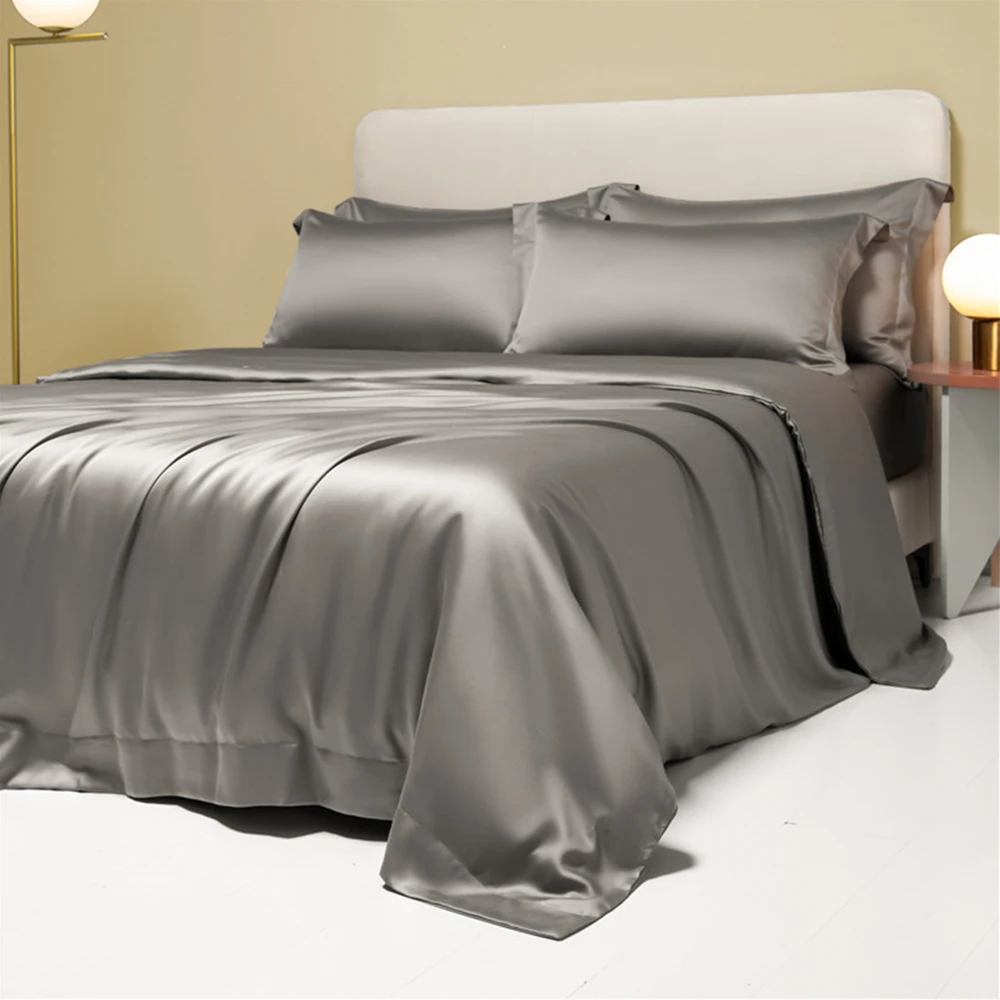
Verification Methods
Simple tests can help identify authentic silk:
* Real silk feels cool to the touch initially but quickly warms
* When rubbed together, real silk creates a subtle warmth while synthetics often create static
* High-quality silk has a distinctive, subtle sheen rather than a plastic-like shine
* Authentic silk has a natural, subtle scent unlike the chemical smell of many synthetics
Understanding these warning signs helps you select the best type of silk bedding for your needs while avoiding inferior products that won’t deliver the true benefits of premium silk.
Silk Alternatives: Options for Various Needs and Preferences
While traditional silk offers exceptional properties, several alternatives provide options for those with specific concerns or preferences. These alternatives each offer unique characteristics worth considering.
Plant-Based Silk Alternatives
For those seeking vegan options, several plant-derived fabrics offer silk-like properties:
Bamboo lyocell provides excellent temperature regulation and softness, though it typically lacks the distinctive sheen of silk. The manufacturing process has improved to become more eco-friendly, making it a sustainable option with good moisture-wicking properties.
Eucalyptus-derived fabrics (often marketed as Tencel or lyocell) offer exceptional breathability and a cool feel similar to silk. These fabrics excel in moisture management but may not provide the same hair and skin benefits as genuine silk.
Silk Blends
Silk blended with other materials can provide a compromise between pure silk and alternatives:
* Silk-cotton blends offer increased durability with moderate silk benefits at a lower price point
* Silk-bamboo combinations may provide enhanced cooling properties
* Silk with minimal synthetic content can improve wrinkle resistance while maintaining most natural benefits
In comparing performance, pure silk generally offers superior thermal regulation, skin benefits, and luxurious feel, while alternatives may provide advantages in specific areas like price, maintenance simplicity, or ethical considerations for those avoiding animal products.
For those specifically concerned about traditional silk production, vegan silk bedding options provide increasingly sophisticated alternatives worth considering. Sanctuary Soft offers high-quality vegan silk bedding that maintains many of the desirable properties of traditional silk through innovative materials and manufacturing techniques.
Frequently Asked Questions About Silk Bedding
Is silk bedding suitable for hot sleepers?
Yes, silk bedding is excellent for hot sleepers because it naturally regulates temperature by wicking away moisture while allowing proper airflow. Unlike synthetic materials that trap heat, silk helps maintain comfortable body temperature throughout the night, preventing overheating and night sweats.
How often should silk bedding be washed?
Silk bedding generally requires washing every 7-14 days, similar to other bedding materials. However, silk’s natural resistance to bacteria and dust mites means it stays cleaner longer than many alternatives. Always follow specific care instructions for your particular silk items to maintain their quality.
Does silk bedding wrinkle easily?
Silk has a natural tendency to develop slight wrinkles, which typically relax when the bedding is in use. Higher momme weights (22+) resist wrinkling better than lighter weights. Many users find silk’s soft wrinkles add to its natural, luxurious appearance rather than detracting from it.
Is silk bedding worth the investment?
For many users, silk bedding provides value that justifies its higher initial cost through extended durability, improved sleep quality, and benefits for skin and hair. When calculating cost per use over its lifespan, quality silk often proves economical compared to frequently replaced lower-quality alternatives.
How long does quality silk bedding typically last?
With proper care, premium silk bedding commonly lasts 5-10 years or more, significantly longer than typical cotton bedding. The exact lifespan depends on momme weight, construction quality, and maintenance practices.
Can silk bedding be used year-round?
Yes, silk’s natural temperature-regulating properties make it suitable for year-round use. It provides insulation in cooler months while wicking away moisture during warmer periods. This versatility makes silk bedding an excellent option for all seasons.
Are there any downsides to sleeping on silk?
The primary considerations are higher initial cost and specific care requirements. Some users may need time to adjust to silk’s smooth surface if they’re accustomed to more textured bedding. Additionally, silk may slide more easily on some mattresses, though proper fitted sheet design minimizes this issue.
How can I tell if my silk bedding is authentic?
Authentic silk feels cool to the touch initially but quickly warms, creates a subtle warmth when rubbed between fingers, burns with a smell similar to burning hair, and transforms to ash when burned rather than melting like synthetics. Reputable sellers provide detailed specifications and certification information for their luxury silk bedding.

